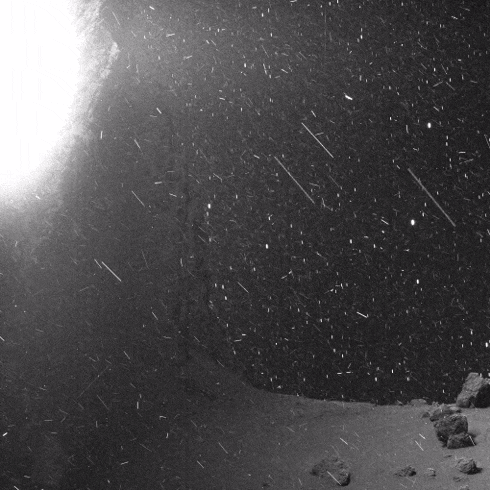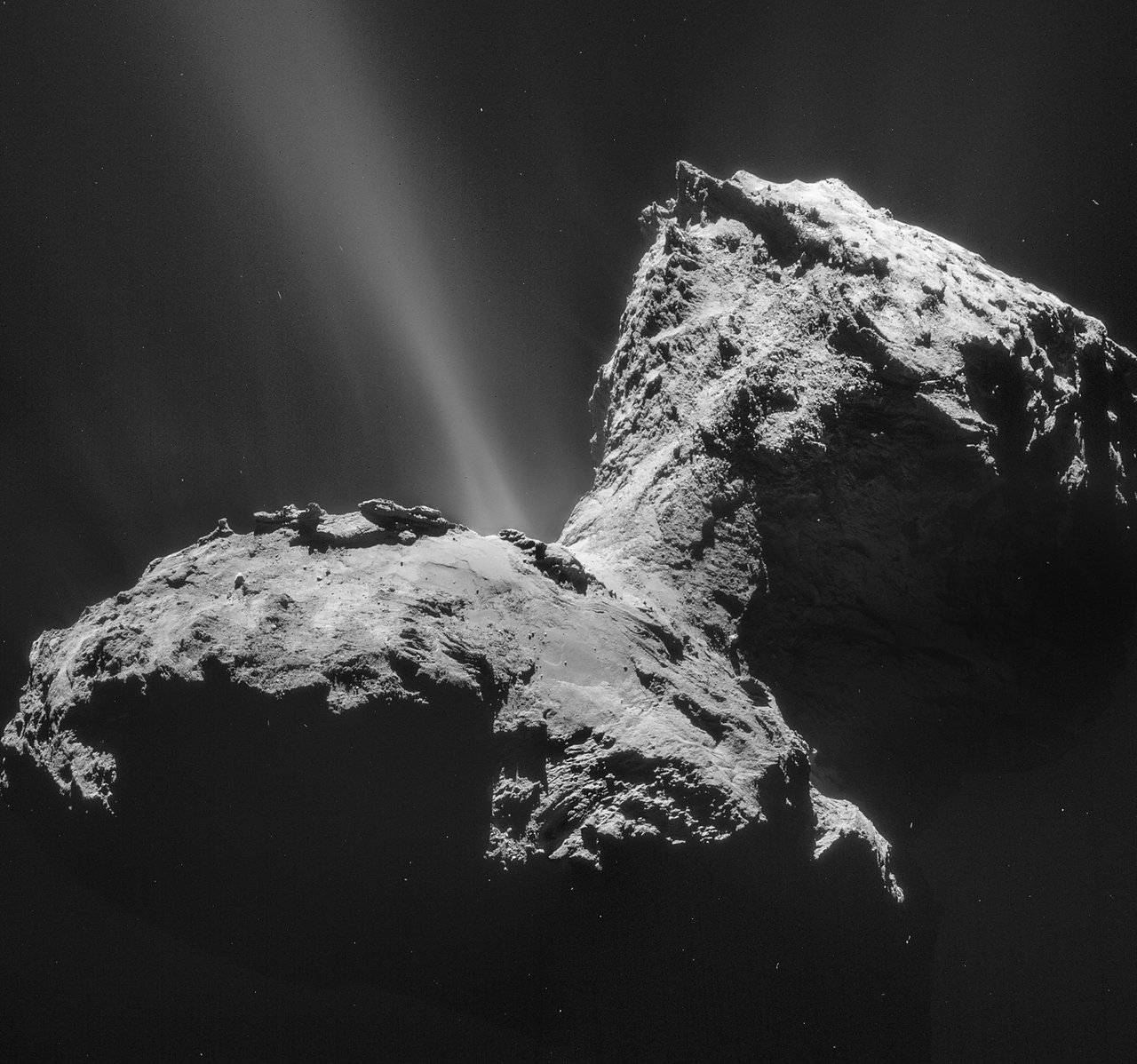The MiARD project (Multi-Instrument Analysis of Rosetta Data) lasted 30 months and was led by Professor Nicolas Thomas from the University of Berne. This project aimed to make optimum use of the Rosetta Mision data. The most significant results have now been published.
A brief review of the Rosetta mission
ESA’s Rosetta mission was designed to understand the formation of our solar system by studying a comet. The task consisted of an orbiter and the lander Philae. After its launch on 2nd March 2004, the probe took another ten years to reach the comet 67P/Churyumov-Gerasimenko at a distance of 6.4 billion kilometers. On 6th August 2014, the time had come, Rosetta had reached its target.
On 12th November 2014, the lander Philae was separated from the Rosetta orbiter. The landing sequence took about seven hours, and the sink rate of Philae was about 1m/s. Shortly after the first confirmation of the landing, however, there were signs that Philae could not anchor himself sufficiently on the comet surface. There were also irregularities in the radio link. The lander bounced off the comet twice before finally coming to a halt about a kilometer from the planned landing point. However, the rebound of Philae allowed conclusions to be drawn about the ground conditions of the intended landing site, which is covered with a 20-centimeter thick layer of dust with the strength of fresh snow. Because of the other landing place and the associated different position, Philae only got sun for 1.5 hours on a comet day of 13 hours. However, the lander was designed for 6 hours of sunlight. As a result, part of the mission could not be completed.
Mosaic of four images taken by Rosetta's navigation camera
Copyright: ESA/Rosetta/NAVCAM, Attribution-ShareAlike 3.0 IGO (CC BY-SA 3.0 IGO)
After almost two years of data collection on the comet, the mission ended on 30th September 2016 with the planned collision of Rosetta with the comet.
"With the placement of the Rosetta probe on the comet Churyumov-Gerasimenko, a unique mission has come to an end that has fascinated us for years. It has brought us close to the exploration of celestial bodies,
says Brigitte Zypries, Federal Government Coordinator for Aerospace.
"The European Rosetta mission has provided the scientists with a wealth of data that they will continue to evaluate and interpret for many years to come.
The Rosetta mission brought us also this fascinating gif from another world. It shows the surface of the comet. The fast-moving light points are dust and cosmic rays, while the slower downwards moving in the background are stars.
Copyright: ESA/Rosetta/OSIRIS, Attribution-ShareAlike 3.0 IGO (CC BY-SA 3.0 IGO)
Evaluation of the data by the MiARD project (Multi-Instrument Analysis of Rosetta Data)
The controlled crash on 30th September 2016 did not mean the end of the scientific work around the Rosetta mission. The international research project MiARD under the direction of Professor Nicolas Thomas from the Physics Institute of the University of Bern aimed to make optimum use of the data collected by Rosetta. Complementary data obtained with different instruments were processed in a way that a numerical model could be developed and tested.
One of the goals of this research is to understand the origins of the solar and planetary systems better.
"Our research results should help explain the behavior of the comet and help to understand its history,"
says Professor Nicolas Thomas.
The MiARD project aims to create fundamental research results that can be applied worldwide. The effects include a high-resolution digital 3D model that can be used by researchers worldwide for investigations. An improved map of geological regions has also been produced.
"Such results are important if humanity ever has to use a comet or distract it from a possible collision course with Earth,"
says Professor Nicolas Thomas also.
A numerical model has also been developed which explains the loss of mass under the influence of the sun. This allows better and more accurate calculation of comet dust orbits.
Meanwhile, more than a dozen publications have emerged from the MiARD project, others are already in preparation. The work will also be used to plan any follow-up missions.
I would have liked to show the mapped comet, but unfortunately all pictures I found have the wrong license.
A four-image mosaic taken from a distance of 28.0 km from the centre of the comet.
Copyright: ESA/Rosetta/NAVCAM, Attribution-ShareAlike 3.0 IGO (CC BY-SA 3.0 IGO)
References:
https://www.dlr.de/dlr/desktopdefault.aspx/tabid-10394/
https://www.dlr.de/dlr/de/desktopdefault.aspx/tabid-10454/662_read-19539#/gallery/24505
https://en.wikipedia.org/wiki/67P/Churyumov%E2%80%93Gerasimenko
https://de.wikipedia.org/wiki/Philae_(Sonde)
http://www.unibe.ch/aktuell/medien/media_relations/medienmitteilungen/2018/medienmitteilungen_2018/neue_kometen_modelle_dank_daten_von_chury/index_ger.html
http://www.miard.eu/
Thank you very much for visiting and reading!
I hope this has been a useful post for you. If you have any questions or suggestions, please don't be afraid to let me know of anything you thought about this post in the comments below!
Yours, @astrophoto.kevin
Copyright note for my pictures:
All images, otherwise clearly indicated, in this post are my own work.
You can use it for free if you credit them to @astrophoto.kevin.

SteemSTEM is a community project with the goal to promote and support Science, Technology, Engineering and Mathematics on the Steem blockchain. If you wish to support the steemSTEM project you can:
Contribute STEM content using the #steemstem tag | Support steemstem authors | Join our curation trail | Visit our Discord community | Delegate SP to steemstem


